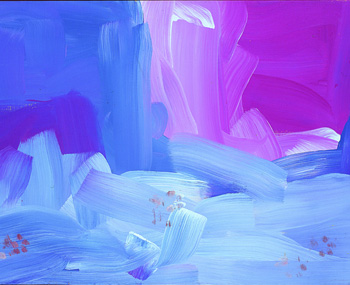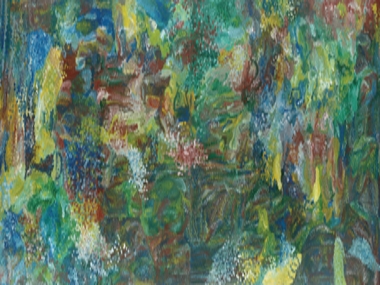The Soul of Emily Kngwarreye

'My Country' (1996) one of Emily's last works; synthetic polymer paint on canvas. Collection of Amanda Howe (c) Emily Kame Kngwarreye. Licensed Viscopy
Jeremy Eccles | 04.01.13
Author: Jeremy Eccles
News source: Urban Times
It often seems to be the case that great Australian achievements need the validation of overseas approval. But the fact that 'Utopia : The Genius of Emily Kame Kngwarreye' was a vast tribute in 2008 to the Aboriginal artist conceived and presented by the Japanese (specifically Prof Akira Tatehata, Director of the National Museum in Osaka) is both a sad foreign validation of something we should have known from the start and a necessary displacement of Emily's art to somewhere it isn't limited by what we all think we know about its origins in a grubby humpy on a semi-desert cattle station called Utopia.
Many questions remain unanswered for Australians about the balance between EKK's oneness with Alhalkere (her Dreaming) and her discovery by the Japanese organisers as “one of the most important abstract painters of the 20th Century”. But, five years later, a young and enthusiastic blogger on the Urban Times website has completely accepted the Japanese embrace – going even further than the good Professor to assert, “Today, an Australian Aborigine by the name of Emily Kame Kngwarreye is mentioned alongside Jackson Pollock, Rothko and De Kooning. And it has even been said (by Prof Terry Smith) that she may one day be known as the greatest.”
It would seem that blogger Damon Isherwood (this was his first blog for the British Urban Times site) may have trained as an architect, but plans to develop a life writing about the human condition – admiring in particular the Australian idealist, Jeremy Griffith. So he may have an aesthetic training, but his underlying purpose in writing could well be to support Griffith's view that Man was once innocent and instinctively good and cooperative. Emily the artist – uncorrupted by the Western art canon - is his soulful paradigm.
But, concentrating on his thoughts about Emily the artist, I wrote in 2008, “So, when you consider Harold Rosenberg's description of de Kooning – the Abstract Expressionist compared in Japan with EKK: “An anguished hero, tormented by perpetual doubt, struggling mightily with each brush stroke to face his authentic self”, we are in a totally different universe to Emily's dauntless confidence which Prof Tatehata believes allowed her to see a blank canvas as vast as the 8 metre long 'Big Yam Dreaming' of 1996 complete in her 80 year old mind's eye”.
Quite clearly EKK was not in her own mind painting abstractly. Her paintings were always about mountain devil lizards, plant seeds, landscape and its seasons, and, above all, her Kame, the Yam Root Dreaming. Her radical changes of style were invariably a reflection of her changing subject-matter – or as Australian curator Margo Neale put it, “Starting a new verse in a song cycle, finding brush-stroke energy in the rhythms of ceremonial dance”.
But Prof Tatehata added special insight when he moved from Western art theory to declare that the painting he'd chosen for the cover of the Osaka catalogue, Emily's last work - a wash of broad brush greys - is “a pure minimal abstraction that gives me a Zen Buddhist sense of Nirvana”. Somehow the Japanese found emotion in work we're too blinkered to see, probably because of our guilt-laden politics.
Intriguingly, Margo Neale brought the exhibition home – but refused to use that extraordinary work on the National Museum's catalogue cover. Black and white yam roots were preferred. Do they lack Nirvana in Canberra?
And do we lack the confidence that overseas curators find in our Aboriginal artists? Incorrectly, Damon Isherwood claims that Emily is the only Australian artist ever to receive a one-person show internationally. In fact, it's an Indigenous speciality with John Mawurndjul, Clifford Possum and Denis Nona all receiving such accolades in Europe.
Yes, we have had Rover and Emily shows (two of each) in Oz; and the National Gallery gave us David Malangi and Albert Namatjira, while Victoria has come up with Ginger Riley and Kitty Kantilla, I think. Impressively, the body called the Museum of Contemporary Art in Sydney has also offered both Paddy Bedford and Lofty Bardayal retrospectives – giving those great men a status alongside Ken Whisson, Christian Marclay and Anish Kapoor.
But there is still a tendency to prefer group or community shows in a way that preferences the ethnographic rather than a single artist's capacity for aesthetic individualism. And far too often, the show celebrates a life that's already passed.
So, all hail to Damon Isherwood for his gauntlet thrown down to the doubting Thomases, especially in European art connoisseurship: “The art critic Walter Benjamin said, 'Either the paintings are traditional and not modern, or modern and not traditional', and yet Emily is somehow utterly and completely both, which is why she has been described as the “impossible modernist (by Prof Tatehata). She managed to transcend any stylistic restraints, and produce works of complete originality and uninhibited beauty”.
I must admit that – as a professional journo – I have my doubts about 'citizen journalism', which is the Urban Times's mode of existence. “We launched Urban Times to tackle the sensationalism and hearsay that permeates the news and media culture of today. Our content is entirely user-generated as citizen journalists and thought-leaders from across the globe submit their content to be edited for free”.
But on this occasion, the citizen has done a fine job. I wonder how he discovered Emily?
URL: Damon Isherwood's article in The Urban Times
My Country 1996
90.0 x 60.0 cm
synthetic polymer paint on canvas
Collection of Amanda Howe
(c) Emily Kame Kngwarreye. Licensed Viscopy 07
Share this:
»  del.icio.us
»
del.icio.us
»  Digg it
»
Digg it
»  reddit
»
reddit
»  Google
»
Google
»  StumbleUpon
»
StumbleUpon
»  Technorati
»
Technorati
»  Facebook
Facebook
Contact Details
Gallery: National Museum of Australia
Email: information@nma.gov.au
Telephone: +61 2 6208 5000
Address: Lawson Crescent Acton Peninsula Canberra 2600 ACT

The million-dollar Emily - 'The Universe' - on display at the Mbantua Museum in Alice Springs.
Further Research
Gallery: National Museum of Australia
Artists: Albert Namatjira | Clifford Possum | David Malangi | Denis Nona | Emily Kngwarreye | Ginger Riley | John Mawurndjul | Kitty Kantilla | Lofty Bardayal | Paddy Bedford | Rover Thomas
News Tags: Akira Tatehata | emily kngwarreye | National Museum of Osaka | urban times | Utopia
News Categories: Asia | Blog | Exhibition | Feature | Industry | News
News Archive
- 11.10.17 | RETURN OF MUNGO MAN
- 10.10.17 | TARNANTHI 2017
- 11.08.17 | Natsiaas 2017
- 08.08.17 | ABORIGINAL ART ECONOMICS
- 02.08.17 | SCHOLL'S NEXT MOVE
- 20.07.17 | APY ART DOMINATES THE WYNNE
- 17.07.17 | Anangu Artist Wins $100,000 Prize
- 14.07.17 | The End of AAMU
- 13.07.17 | YOU ARE HERE
- 11.07.17 | ART ACROSS THE COUNTRY
- 11.07.17 | TARNANTHI IN OCTOBER
- 05.07.17 | TJUNGUṈUTJA - from having come together
- 02.07.17 | BENNELONG
- 27.06.17 | JIMMY CHI
- 23.06.17 | Blak Markets at Barangaroo
Advertising

